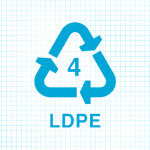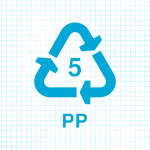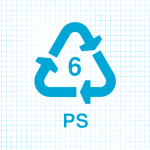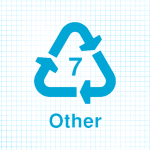Plastic plays a significant role in our daily lives, but it’s essential to manage its environmental impact responsibly. The plastics coding system, marked with recycling codes, aims to facilitate the sorting and recycling of plastics by resin type. These codes guide Material Recovery Facilities (MRFs) in separating plastics, ensuring clean and reusable recycling streams. Let’s delve into the world of plastic recycling codes to make informed choices for a sustainable future:
Demystifying Recycling Codes #
Each plastic container larger than a fist is typically marked with a recycling code surrounded by three chasing arrows. These codes range from 1 to 7, indicating the material used to create the bottle. Here’s a breakdown of what each code represents:
 PET (Polyethylene Terephthalate – PETE) #
PET (Polyethylene Terephthalate – PETE) #
This code signifies the use of PET, a commonly used plastic for items like beverage bottles and food containers. PET is highly recyclable and can usually be placed in single-stream recycling bins.
 HDPE (High-Density Polyethylene) #
HDPE (High-Density Polyethylene) #
HDPE is known for its strength and durability, making it ideal for products such as milk jugs and detergent bottles. Like PET, HDPE is easily recyclable and accepted in single-stream recycling.
 PVC (Polyvinyl Chloride – V) #
PVC (Polyvinyl Chloride – V) #
PVC is primarily used for items like pipes and vinyl flooring. Unfortunately, PVC is not recyclable and poses challenges for waste management.
 LDPE (Low-Density Polyethylene) #
LDPE (Low-Density Polyethylene) #
LDPE is a flexible plastic commonly found in plastic bags, shrink wrap, and squeezable bottles. It is recyclable but might not be accepted in all regions. Brand marketers should educate customers about specific recycling opportunities.
 PP (Polypropylene) #
PP (Polypropylene) #
PP is used in products such as yogurt containers, bottle caps, and some food packaging. Like LDPE, its recyclability depends on regional recycling programs.
 PS (Polystyrene) #
PS (Polystyrene) #
Polystyrene, often used for disposable food containers and foam products, can sometimes be recycled, but it faces limitations in the recycling process.
 OTHER #
OTHER #
This code is a catch-all for materials not categorized under the previous six codes. Products with this code may have unique recycling or disposal requirements, so it’s crucial to check with local recycling facilities.
Deciphering the Impact #
Understanding these codes empowers consumers to make eco-conscious choices. PET (1) and HDPE (2) are reliable choices for recycling and can typically be placed in single-stream recycling bins. In contrast, PVC (3) cannot be recycled, making it important to seek alternatives when possible.
LDPE (4) and PP (5) are recyclable in many areas, but their acceptance may vary by location. This emphasizes the role of brand marketers in educating consumers about local recycling opportunities.
PS (6) and OTHER (7) materials may offer recycling options in some instances, but they often require more specialized processing.
Embracing Sustainability #
Recycling codes are more than just numbers and symbols; they represent a commitment to environmental responsibility. By choosing products with recyclable codes and ensuring they end up in the appropriate recycling streams, we can collectively reduce our environmental footprint.
As a responsible brand marketer or consumer, it’s essential to stay informed about regional recycling guidelines and support initiatives that promote sustainability. Together, we can contribute to a greener, more sustainable future.




